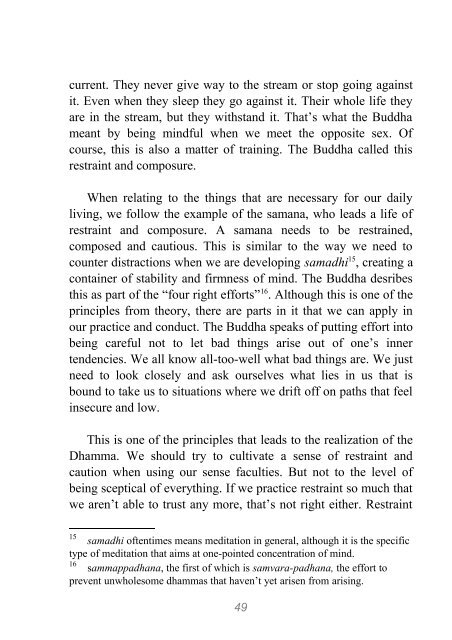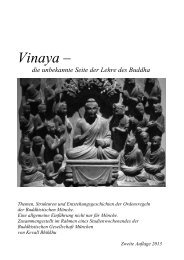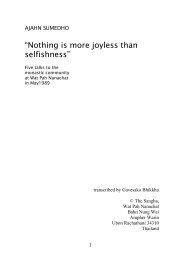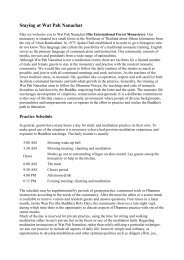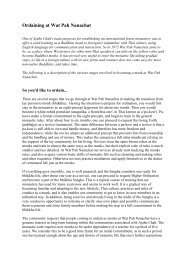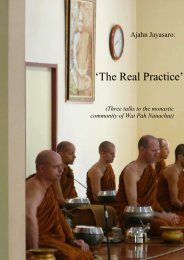Luang Por Liem: The Ways of the Peaceful - Wat Pah Nanachat
Luang Por Liem: The Ways of the Peaceful - Wat Pah Nanachat
Luang Por Liem: The Ways of the Peaceful - Wat Pah Nanachat
Create successful ePaper yourself
Turn your PDF publications into a flip-book with our unique Google optimized e-Paper software.
current. <strong>The</strong>y never give way to <strong>the</strong> stream or stop going against<br />
it. Even when <strong>the</strong>y sleep <strong>the</strong>y go against it. <strong>The</strong>ir whole life <strong>the</strong>y<br />
are in <strong>the</strong> stream, but <strong>the</strong>y withstand it. That’s what <strong>the</strong> Buddha<br />
meant by being mindful when we meet <strong>the</strong> opposite sex. Of<br />
course, this is also a matter <strong>of</strong> training. <strong>The</strong> Buddha called this<br />
restraint and composure.<br />
When relating to <strong>the</strong> things that are necessary for our daily<br />
living, we follow <strong>the</strong> example <strong>of</strong> <strong>the</strong> samana, who leads a life <strong>of</strong><br />
restraint and composure. A samana needs to be restrained,<br />
composed and cautious. This is similar to <strong>the</strong> way we need to<br />
counter distractions when we are developing samadhi 15 , creating a<br />
container <strong>of</strong> stability and firmness <strong>of</strong> mind. <strong>The</strong> Buddha desribes<br />
this as part <strong>of</strong> <strong>the</strong> “four right efforts” 16 . Although this is one <strong>of</strong> <strong>the</strong><br />
principles from <strong>the</strong>ory, <strong>the</strong>re are parts in it that we can apply in<br />
our practice and conduct. <strong>The</strong> Buddha speaks <strong>of</strong> putting effort into<br />
being careful not to let bad things arise out <strong>of</strong> one’s inner<br />
tendencies. We all know all-too-well what bad things are. We just<br />
need to look closely and ask ourselves what lies in us that is<br />
bound to take us to situations where we drift <strong>of</strong>f on paths that feel<br />
insecure and low.<br />
This is one <strong>of</strong> <strong>the</strong> principles that leads to <strong>the</strong> realization <strong>of</strong> <strong>the</strong><br />
Dhamma. We should try to cultivate a sense <strong>of</strong> restraint and<br />
caution when using our sense faculties. But not to <strong>the</strong> level <strong>of</strong><br />
being sceptical <strong>of</strong> everything. If we practice restraint so much that<br />
we aren’t able to trust any more, that’s not right ei<strong>the</strong>r. Restraint<br />
15 samadhi <strong>of</strong>tentimes means meditation in general, although it is <strong>the</strong> specific<br />
type <strong>of</strong> meditation that aims at one-pointed concentration <strong>of</strong> mind.<br />
16 sammappadhana, <strong>the</strong> first <strong>of</strong> which is samvara-padhana, <strong>the</strong> effort to<br />
prevent unwholesome dhammas that haven’t yet arisen from arising.<br />
49


